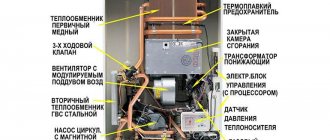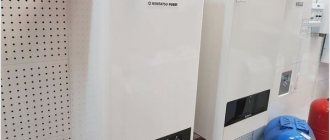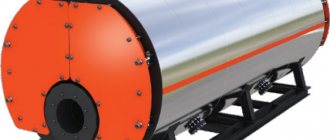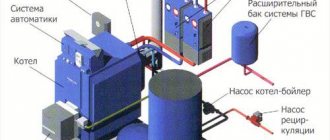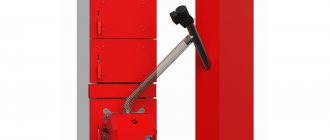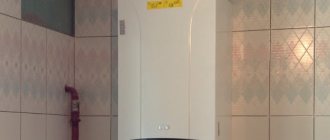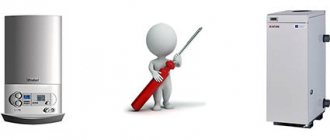Home / Boiler rooms
Back
Published: 06/12/2019
Reading time: 4 min
4
9396
One of the most common types of industrial heating equipment is the fire-tube boiler. They are distinguished by their simple design, high reliability and the possibility of re-equipment.
Having small dimensions, they are distinguished by high thermal performance while being safe. There are several models that differ in design, power, and fuel consumption.
- 1 Fire tube boiler design
- 2 Operating principle
- 3 Types of fire tube boilers
- 4 Difference between a fire tube boiler and a water tube boiler
- 5 Best Russian Manufacturers
Fire tube boiler design
A simple operating principle determines the design. The body shape can be varied, but the most common is the cylinder shape. On one side there is a combustion chamber, and on the other side there is a smoke removal system. Combustion is supported by a forced blowing device.
Above the firebox there are heat exchangers that are in contact with the smoke exhaust duct. For increased heating efficiency, the heat exchanger is made of small cross-section pipes. The most common are three-pass fire-tube boilers. Its main difference from the conventional design is the presence of three smoke exhaust channels.
The first channel is considered to be the firebox, and the other two are located above one another. The fan provides the necessary draft, and there is also natural draft through the grates and ventilation holes.
A feature of three-pass boilers is the reduction in the temperature of heated flue gases from 1000˚C to 250˚C, ensuring maximum heat transfer. But this is fraught with the fact that the water level is unstable and cannot be controlled. This can be solved by using a separator that separates steam and water, and drops do not enter the collector.
In addition to the specified parts, the installations are equipped with the following components to improve their characteristics:
- air outlet channels;
- steam pressure gauge;
- coolant thermometer;
- control unit;
- pressure controllers;
- emergency protection.
Boiler features:
Water-tube and gas-tube boilers differ in the movement of heat exchange media relative to each other. In the first case, heat exchange is carried out due to the fact that pipes filled with water or a steam-water mixture are heated from the outside by flue gases. In the second case, everything happens the other way around - the internal space of the pipes is filled with gases, and their outer part is in contact with the coolant, which is usually water or oil.
Water-tube boilers are more advanced than gas-tube boilers, which become increasingly obsolete over time and are replaced by water-tube boilers due to lack of power, greater explosion hazard, increased requirements for water quality, and more.
When choosing a steam boiler, you can pay attention to its main technical and economic indicators. Based on the operating characteristics of a steam boiler, which reflects heat exchange in certain places of its structure, which are working surfaces, it is possible to analyze the efficiency of its operation. You can view miura steam boilers on the official website.
Principle of operation
The operating principle of a fire tube boiler is to transfer thermal energy from burning fuel to the coolant. The vaporization process occurs at a temperature of 115˚C and a pressure of 0.7 kgf/sq.cm. The fuel is burned in a combustion chamber, which is cooled with water, except for the front side. When water is heated, steam formation occurs; the steam is accumulated in a suitable reservoir connected to the heating system. Exhaust gases are removed through a bundle of pipes.
Photo source: pudeb.com
Fuel for boilers can be varied: liquid, solid and gaseous. The equipment is a gas-tube installation with flame tubes in which burning fuel circulates. The flame tubes have a low-pressure gas burner and forced pressurization. The flame tube is a kind of combustion chamber within which the supplied fuel is burned.
The difference between a fire tube boiler and a water tube boiler
High-performance heat-generating boilers are divided by their design into fire-tube and water-tube. The peculiarity of fire tubes is that the heating surface consists of tubes through which the burned fuel moves. And the heating of the coolant located outside the tubes occurs through heat exchange. Fire tube boilers are also divided into transient boilers - gases pass without turning and circulating boilers - gases turn in the chamber while moving. Most often, this equipment is made in the form of a horizontal cylinder. Hot water boilers, such as KVR or KVA, contain heated water inside. The heating surface is located in the center of the boiler or below.
Three pass fire tube boiler
A burner for burning gas or diesel fuel is installed at one end. Above the heating elements there is a smoke pipeline through which combustion products are directed into the chimney. Based on the number of circuits, installations are divided into two-way and three-way. In the first, a reversible combustion chamber operates, where the gases rest against the rear surface of the unit, then they turn around and go to the front, after reflection from which the gases change direction towards removal from the boiler. In a three-pass scheme, the gases, when returning to the front surface, pass through another flame tube or through a series of smoke tubes. After which, having been reflected, the gases are removed from the unit.
The main advantages of fire tube boilers:
- simple design;
- made of inexpensive metal;
- compactness;
- simple maintenance;
- easy thermal calculation
Disadvantages when operating fire tube boilers:
- requirements for the quality of make-up water. This is due to low circulation rates. Therefore, this equipment must not be connected to heating systems due to high sludge formation in radiators;
- high explosion hazard. If there is a large amount of hot water in the boiler and the pressure suddenly drops due to structural failures, then steam is instantly released, accompanied by an explosion;
- high aerodynamic resistance;
- the need to maintain the temperature of a large volume of water even in the absence of demand, otherwise, when cooling, you have to spend a lot of time heating.
A water-tube boiler has the opposite operating principle; its heating element is a series of pipes through which heated water moves, and heat exchange occurs by heating the pipes by burning fuel. The most common and simple type of heat exchanger is a unit consisting of two pipes welded together by several transverse pipes.
The advantages of water tube boilers are as follows:
- no danger of explosion;
- fast heat exchange;
- light weight of the equipment;
- reliable design;
- There are no special requirements for water quality.
Disadvantages of such equipment:
- the quality of seams and connections must be high;
- more complex device;
- difficult maintenance.
Fire tube equipment is the most widely represented on the Russian market. This is a consequence of simpler technology and simpler maintenance. However, due to their advantages, part of the market still belongs to water tube boilers, despite their low popularity.
Operating principle of a fire tube boiler
A fire tube boiler most often looks like a horizontal cylinder.
There is a burner inside, hot gases from which enter a system of pipes around which there is water. Water, in contact with pipes whose temperature is 115 degrees, heats up and turns into steam, which is then collected in a special tank.
Fire tube boilers are still used in industry, as they have a simple, understandable design. In addition, their production, maintenance and repair do not require significant material investments.
After all, inexpensive steel grades are used to make the case. The disadvantage is the high risk of explosion. If the pressure inside the boiler changes, it may explode.
This is also facilitated by deposits on the walls, which arise due to the low speed of the coolant. To operate such boilers you need a large amount of fuel, since you have to heat a lot of water.
The best Russian manufacturers
Among Russian manufacturers it is worth highlighting several enterprises:
- Borisoglebsk Boiler and Mechanical Plant. The company produces fire tube equipment operating on solid, liquid fuel and gas. The equipment is equipped with burners and automatic control and safety systems. Devices of our own production. The boilers have three-stage power control, allowing for autonomous operation.
- Industrial group "Generation" (Berezovsky, Sverdlovsk region). The line of fire tube boilers consists of equipment with a capacity of 1 to 2.5 tons/hour. This equipment is used to produce low pressure steam in industry. The boiler circuit is three-pass. The package includes burners that are available in two versions: automated single-fuel and dual-fuel. The advantages of the units are high efficiency - up to 91%, simple design, high repairability.
- JSC "Boiler Equipment Plant" (Belgorod region, Alekseevsky district, Alekseevka). The company produces fire-tube boilers with high efficiency. Steam equipment operates according to a three-pass circuit. The boilers are produced in a wide range with steam production from 2 to 25 t/h, and pressure up to 25 bar.
- Russian power engineering plant JSC Polycraft Energomash. The plant produces boilers with steam output from 0.5 to 5.0 tons/h, have 11 standard sizes and operate on gaseous and diesel fuel. The equipment is equipped with automatic protection.
- JSC Shebekinsky Machine-Building Plant (Shebekino, Belgorod region) manufactures steam fire-tube boilers of the KP and KPa brands with a steam output of 1 to 4 tons/h. Among the advantages: a spiral turbulator, lining the front cover with refractory concrete. The boilers meet the requirements of Rostechnadzor.
Ready-made drawings and projects of chimneys
Mast
watch Mast chimneys are designed for removing flue gases from boiler houses operating on liquid,…
Self-supporting
watch The self-supporting chimney is designed to remove combustion products and provide natural draft into the fuel...
Facade and flue ducts
see The façade (wall) chimney consists of separate insulated sectional chimneys and roof elements…
On guy ropes
look Chimneys on guy wires are a single-barrel vertical steel structure, fixed with a steel...
Truss
watch Truss chimneys are a steel lattice tower of SRB and thermally insulated gas suspended on it...
Columned
watch The column chimney is a structure consisting of a metal supporting outer shell and a gas outlet…
Selection of materials for the construction of boiler chimneys
When determining the material, it is necessary to take into account its positive and negative aspects:
- The brick has high mechanical strength, heat capacity and a fairly high degree of fire safety. Disadvantages: sedimentation of condensate and soot containing sulfur oxides. When interacting with water, acids are formed that destroy the material. Contamination in the passage reduces the speed of passage of gases and leads to overturning of the draft. Height: 30-70 m with a permissible diameter of 0.6/8 m.
- Ceramics are highly fire-resistant and resistant to condensation and environmental influences. Disadvantage: significant weight, requiring the installation of an additional foundation, which increases the complexity of installation and its cost.
- Polymer materials can be used in gas equipment. They have high strength, lightness and flexibility. Maximum load temperature: 250⁰C.
- Steel chimneys: a mobile structure consisting of many elements. Quite easy to install and have the ability to be disassembled and moved in the future. They are relatively light in weight and resistant to condensation. The soot is debugged slightly, and they have a high rate of passage of flue gases. Limited in height to 30-40 m with a diameter of 0.4 -1 m.
- Reinforced concrete is used for large industrial areas, the permissible height is up to 300 m with a diameter of up to 10 m.
